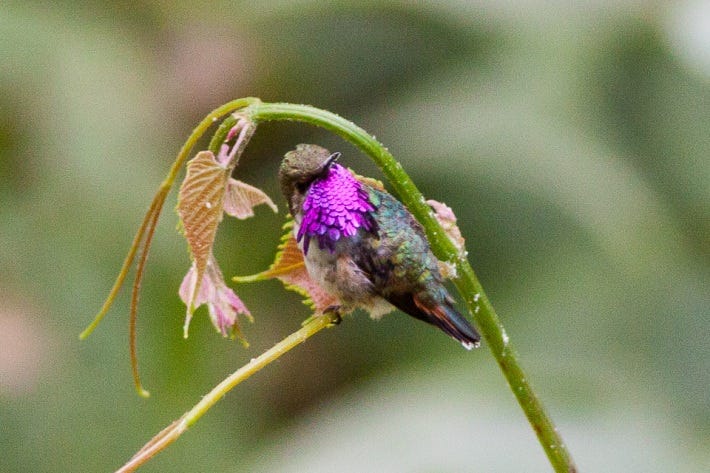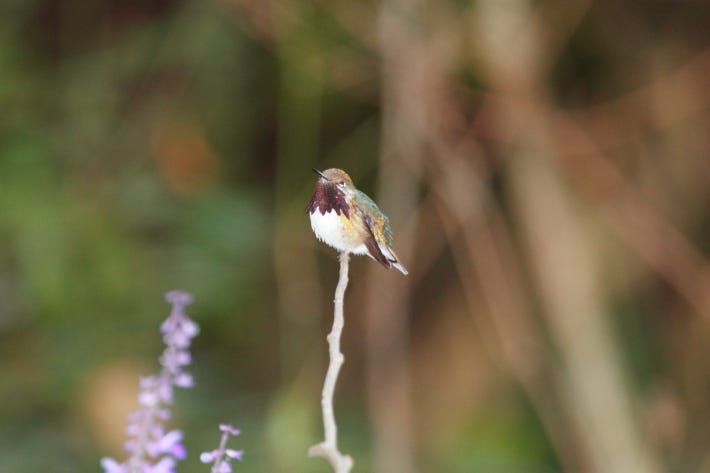Bird of the Week: Bumblebee Hummingbird
Meet the second-smallest bird in the world. Like, all of it.
This week's Bird of the Week is a thing of wonder: the bumblebee hummingbird.
Let's say hello.

First off, stunning bird! The jeweled magenta ring, the shimmering green feathers, the jaunty stance—top-notch bird stuff going on here. This picture was taken in Mexico, in whose ancient, humid forests the bumblebee hummingbird can be found. (Note: the forests are being threatened by destruction and climate change, because of course they are.)
Second, you will notice that this picture is quite zoomed in. That is because the bumblebee hummingbird is a small bird. In fact, it is the second-smallest bird in the entire known world! (The smallest is the very similarly named but still separate bee hummingbird.) Could there be another second-smallest bird out there somewhere? Sure, it's possible, but nobody has ever seen one.
How small are we talking? Let's turn to Beauty of Birds (emphasis mine):
It averages 2.75 inches or 7 cm in length and weighing, on average, 0.1 oz or 3 grams. They are comparable in size to bumblebees and are lighter than a Canadian or U.S. penny.
A bird...the size of a bumblebee...my head is spinning. The picture above is a roughly life-sized portrait! And it's lighter than a freaking penny?! Amazing. Here's another picture.

Look at it! Just perched like that! But the sobriquet is not just because of the size of the bird. There's more going on—some very cloak-and-dagger Ocean's Eleven-style heist things. Here's Simon Barnes from the World Land Trust (emphasis mine):
It doesn’t get the name just for being small...it also flies in the jerky, preoccupied manner of a bee and the hum of its wings sounds like the buzz of a bee.Hummingbirds are almost laughably aggressive birds. Their feeding territory is their life, and they will busily and nosily repel all species of hummingbirds from their patch. But the Bumblebee Hummingbird can often slip into the same patch of flowering forest, and the resident hummingbird will pay it no mind: it’s only a bloody bee, ignore it, it’s not a threat. Their disguise confuses the dominant hummingbird and allows them to drink their fill of nectar, hiding in plain sight.
Oh my god. Nature, you crazy thing. There is a bird the size of a little bee out here that is just repeatedly dunking on the other, bigger birds using its craftiness?? How can we not stan? One more pic.

Now, you will have noticed the wildly cool magenta ring wrapped around the bumblebee hummingbird's neck. (Sadly, as with so many colorful things on birds, only the men have them. Patriarchy is real!) But what if I told you that this feature changes color with the light???? It's true!
As the Cornell Lab of Ornithology helpfully notes:
This is known as iridescence, a common, showy feature of many birds' plumages, from hummingbirds to starlings to jays to ducks. Iridescence doesn't exist as a pigment—it is a structural color created by light striking the feathers. In each iridescent feather, keratin, melanin, and air are arranged in such a way that the appearance of the feather changes at different viewing angles.
You should also click over to this clip from PBS, which I cannot embed, that shows just how ornery the bumblebee hummingbird is—and how it uses that magenta ring in fights. Hummingbirds love to fight! And we love them for it — especially the bumblebee hummingbird. Birds...what will they come up with next???
A reminder: you can check out our complete Bird of the Week list here, and get in touch with your bird suggestions at hello@discourseblog.com.




